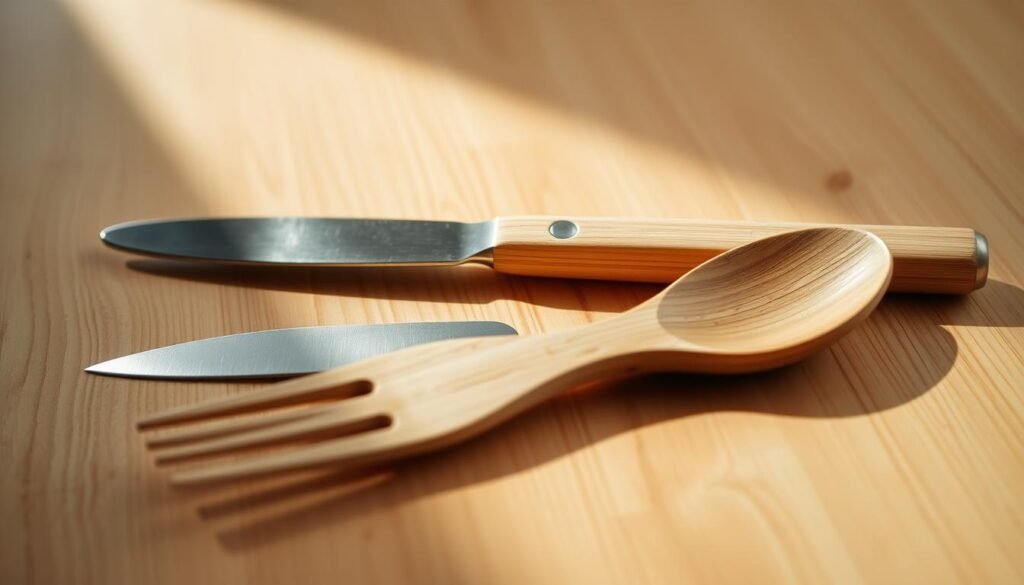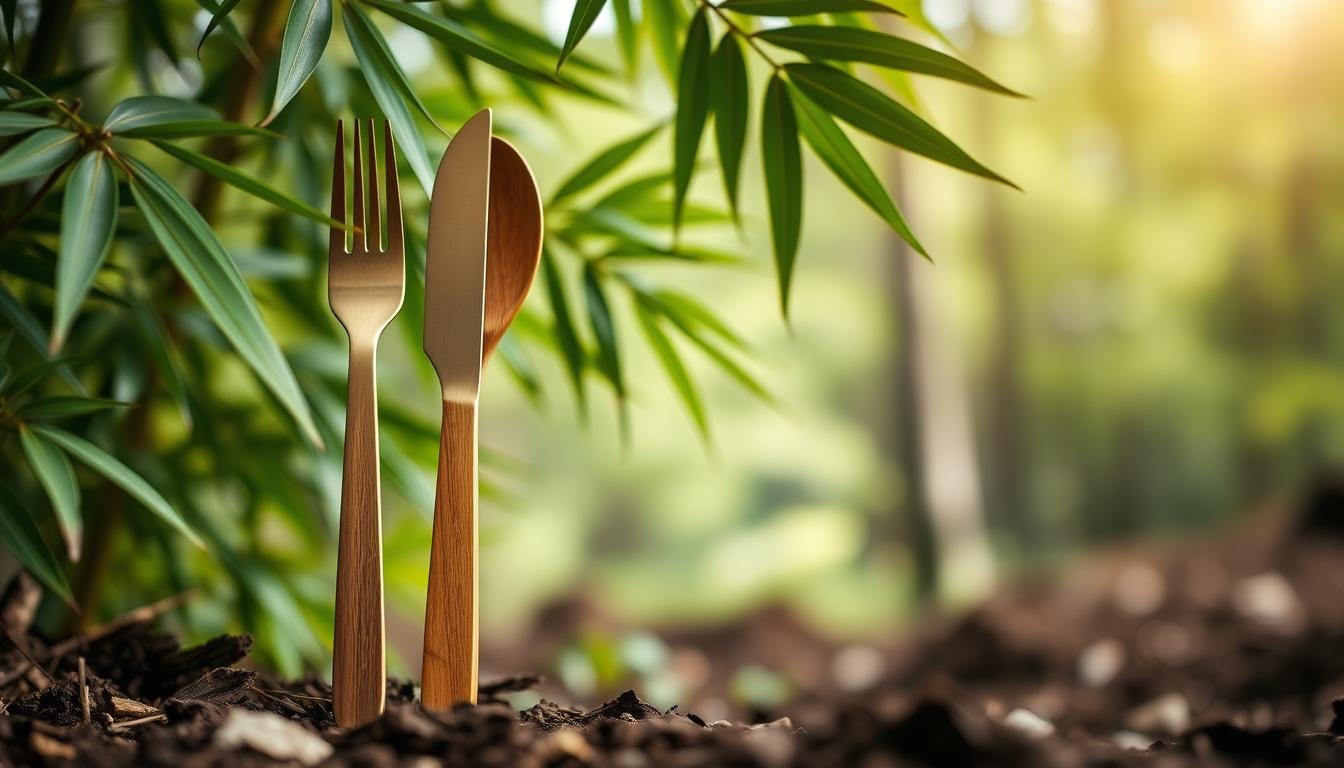As we try to lessen our impact on the environment, a question pops up: is bamboo silverware really eco-friendly? We dive into the sustainability of this popular choice.
Bamboo utensils are becoming more popular because they seem eco-friendly. But, how sustainable are they really? We look at how they’re made, how long they last, and their environmental effect to give a full picture.
We explore the good and bad of bamboo silverware. We check if it’s good for the planet and if it’s right for those who care about the environment.
Key Takeaways
- Eco-friendly alternatives to traditional kitchenware are on the rise.
- Bamboo silverware offers a sustainable option with several benefits.
- The production process and durability of bamboo utensils impact their eco-friendliness.
- Assessing the environmental impact is key for making smart choices.
- Bamboo silverware can be a good choice for those looking for eco-friendly kitchenware.
What Is Bamboo Silverware?
Bamboo is known for growing fast and being easy to replace. It’s now used to make strong and green silverware. This change is making our kitchen tools and dining items better for the planet.
Overview of Bamboo Silverware
Bamboo silverware is made from bamboo, a plant that grows quickly and doesn’t need much water or pesticides. It’s a great choice instead of metal, plastic, or wood. Bamboo silverware is not only good for the environment but also lasts long and looks nice.
Common Uses
Bamboo silverware is useful in many places, such as:
- Foodservice and catering events
- Corporate and public gatherings
- Outdoor activities like camping or picnics
- Daily household use for those looking for sustainable options
Types of Bamboo Silverware
Bamboo silverware comes in different types for different needs. The most common types are:
| Type | Description | Use Case |
|---|---|---|
| Forks | Durable and designed for both solid and semi-solid foods | Ideal for salads, pasta, and desserts |
| Knives | Crafted for cutting through various textures | Perfect for slicing fruits, bread, and more |
| Spoons | Comfortable to hold and designed for soups, cereals, and desserts | Great for both hot and cold dishes |
These types of bamboo silverware are available in various styles and designs. They fit different occasions and personal tastes.
Benefits of Using Bamboo Silverware
Bamboo silverware is great for those who care about the planet. It’s a top pick for those looking for green alternatives. Let’s dive into why it’s so popular.
Eco-Friendliness
Bamboo silverware is made from 100% natural and non-toxic materials. It’s safe for you and the environment. Unlike plastic or metal, bamboo breaks down easily and can be composted.
Biodegradable and Renewable
Bamboo silverware is biodegradable. Bamboo grows fast, ready in just three to five years. This is much quicker than traditional wood, which takes decades. So, bamboo is a very green choice for making silverware.
Lightweight and Portable
Bamboo silverware is also lightweight and portable. It’s perfect for outdoor fun like camping or picnics. Plus, it’s tough enough for everyday use.
| Benefits | Description |
|---|---|
| Eco-Friendliness | Made from 100% natural and non-toxic materials, biodegradable and compostable. |
| Biodegradable and Renewable | Highly renewable resource with a short growth cycle, making it sustainable. |
| Lightweight and Portable | Ideal for outdoor activities and daily use due to its durability and portability. |
Drawbacks of Bamboo Silverware
Bamboo silverware is good for the environment, but it has some downsides. It’s important to know these to make a smart choice.
Durability Concerns
Bamboo silverware isn’t as durable as metal. It can break or splinter if not handled right. This makes it last less than other materials.
Price Range Compared to Alternatives
Bamboo silverware costs more than plastic or metal. The price comes from using sustainable materials and making it into silverware. Some people are okay with paying more for eco-friendly items, but others might find it too expensive.
Limited Availability
It’s also hard to find bamboo silverware in some places. Unlike plastic or metal, it’s not as common in stores. This can be a problem for those who like to shop in person.
In summary, bamboo silverware has its benefits, but we must also consider its drawbacks. Thinking about durability, cost, and availability helps us make better choices for the environment.
Price Ranges for Bamboo Silverware
Bamboo silverware comes in many prices, from cheap to expensive. As more people want green kitchen items, knowing the prices is key.
Budget Options
Looking for something cheap? Bamboo silverware is affordable. Budget-friendly options cost between $5 and $15 for a set. It’s perfect for those starting to go green.
Mid-Range Selections
Want something good but not too pricey? Mid-range bamboo silverware is for you. It costs $15 to $30 per set. Mid-range selections are durable and eco-friendly.
Premium Brands
Ready to splurge on top-notch bamboo silverware? Premium brands offer the best. They have durable, stylish, and high-quality items. Prices start at $30 or more per set.
https://www.youtube.com/watch?v=tOJj82Bfk3g
| Price Category | Price Range | Features |
|---|---|---|
| Budget | $5-$15 | Basic, affordable, entry-level |
| Mid-Range | $15-$30 | Better craftsmanship, durable |
| Premium | $30+ | High-quality, unique designs, advanced materials |
Knowing the price ranges helps you choose bamboo silverware that fits your budget and values. Whether you pick something cheap, mid-range, or premium, you’re choosing a greener option.
Durability of Bamboo Silverware
Bamboo silverware is becoming more popular because it’s durable. It’s great for those who care about the environment. Its ability to last through daily use is a big plus.
Lifespan Compared to Wood
Bamboo silverware lasts longer than wooden utensils. Wood can crack or splinter, but bamboo is more durable. This is because bamboo is naturally denser, making it less likely to wear out.
Here’s a comparison of the average lifespan of bamboo and wooden silverware:
| Material | Average Lifespan | Common Issues |
|---|---|---|
| Bamboo | 2-5 years | May develop cracks with improper care |
| Wood | 1-3 years | Prone to splintering and cracking |
Resistance to Heat and Moisture
Bamboo silverware is good at handling heat and moisture. But, it’s important to take care of it to keep it in good shape.
Key benefits include:
- Resists warping when exposed to normal heat
- Doesn’t crack easily due to moisture
- Easy to clean and keep up
Care for Longevity
To make your bamboo silverware last longer, follow these care tips:
- Wash it by hand with mild soap.
- Dry it well to avoid moisture buildup.
- Don’t expose it to extreme temperatures.
- Apply a bit of oil now and then to keep it moist.
By taking care of your bamboo silverware, it will last longer. This makes it a great choice for your eco-friendly kitchen.
Sustainability of Bamboo Production
Bamboo is a green choice for many reasons. It grows fast, reaching full size in just three to five years. This is much quicker than traditional wood, which takes decades.
Bamboo Growth and Harvesting
Bamboo grows quickly and can regrow after being cut down. This means it doesn’t need replanting, which is good for the environment. We’ll look at how bamboo grows and how it’s harvested.
Key aspects of bamboo growth and harvesting include:
- Rapid growth rate, allowing for frequent harvesting
- Regrowth after harvesting without replanting
- Low water requirements compared to other crops
Impact on Forest Ecosystems
Bamboo is good for forests. It keeps the soil healthy, stops erosion, and helps animals. But, too much bamboo farming can harm local ecosystems.
To avoid these problems, we need to farm bamboo in a way that’s good for the environment. This means keeping areas for other plants, protecting native animals, and not cutting down forests.
Comparison with Traditional Wood Sources
Bamboo is better than traditional wood in many ways. It grows faster, uses less water, and needs fewer chemicals. Here’s a comparison:
| Characteristics | Bamboo | Traditional Wood |
|---|---|---|
| Growth Cycle | 3-5 years | 20-100 years |
| Water Requirements | Low | Variable, often high |
| Pesticide Use | Minimal | Variable, can be high |
The table shows bamboo is more eco-friendly than traditional wood. This makes bamboo a great choice for products like silverware.

Bamboo Silverware vs. Other Materials
Bamboo silverware is becoming more popular. But how does it compare to other materials? Let’s look at bamboo against cotton, polyester, and wood to make better choices.
Cotton Silverware
Cotton silverware is eco-friendly, but it’s not as durable as bamboo. It’s made for disposable use.
- Cotton silverware wears out faster and is more prone to damage.
- It’s not as good at handling moisture, which limits its use.
- But, cotton is biodegradable and can be composted, like bamboo.
Polyester Alternatives
Polyester silverware is durable and resists moisture well. But, it’s made from plastic, which is a concern for the environment.
- Polyester silverware lasts longer and can be washed many times.
- It’s also cheaper than bamboo or cotton.
- Yet, it’s made from non-renewable resources, which harms the environment more.
Wooden Silverware Comparisons
Wooden silverware is also eco-friendly. Let’s compare it to bamboo.
| Material | Eco-Friendliness | Durability | Cost |
|---|---|---|---|
| Bamboo | Highly renewable, biodegradable | Moderately durable | Moderate |
| Wood | Renewable if sourced sustainably, biodegradable | Can be durable, depends on wood type | Can be higher |
| Cotton | Biodegradable, compostable | Less durable | Generally lower |
| Polyester | Less eco-friendly due to plastic origin | Highly durable | Often less expensive |
Each material has its own advantages and disadvantages. Bamboo silverware is eco-friendly and moderately durable. Think about your needs, environmental values, and budget when choosing.
Care and Maintenance Tips for Bamboo Silverware
Keeping your bamboo cutlery in good shape is easy. We’ll show you how to take care of it. This way, your bamboo silverware will last longer.
Cleaning Guidelines
Hand-washing is best for your bamboo silverware. Use mild soap and warm water. Don’t soak it for too long to avoid damage.
- Use a soft sponge or cloth to clean the cutlery.
- Avoid using abrasive cleaners or scouring pads.
- Rinse thoroughly with clean water.
Storing Best Practices
After washing and drying, store your bamboo cutlery in a dry spot. This stops moisture from causing damage or mold. Store it in a place with good air flow or a breathable container.
Avoiding Damage
Don’t let your bamboo silverware get too hot or cold. Proper care will extend the lifespan of your bamboo cutlery.

By following these easy care tips, your bamboo silverware will last longer. You’ll also keep its eco-friendly benefits.
Pros & Cons of Bamboo Silverware
Bamboo silverware is a unique eco-friendly option. It has both benefits and drawbacks. We’ll look at what makes it good and what might not be so great.
Advantages of Bamboo Silverware
Bamboo silverware is great for the environment. It’s made from a renewable resource. Here are some of its best points:
- Eco-friendliness: Bamboo is a green choice for cutlery.
- Biodegradable: It breaks down, unlike plastic, which helps the planet.
- Lightweight and Portable: It’s easy to take with you.
Disadvantages of Bamboo Silverware
But, there are some downsides to consider:
- Durability Concerns: It might not last as long as metal.
- Limited Availability: You might not find it everywhere.
- Price Variability: Prices can vary, sometimes being higher than other options.
Let’s see a comparison in a table:
| Feature | Bamboo Silverware | Metal Cutlery | Plastic Cutlery |
|---|---|---|---|
| Eco-friendliness | High | Medium | Low |
| Durability | Medium | High | Low |
| Cost | Variable | Medium to High | Low |
In conclusion, bamboo silverware is a good eco-friendly choice. But, it has some downsides. Knowing these can help you decide if it’s right for you.
Frequently Asked Questions about Bamboo Silverware
Exploring bamboo silverware raises many questions. We’ll answer some common ones to help you decide if bamboo cutlery is right for you.
Safety for Food Use
Bamboo silverware is safe for eating. It’s made from natural bamboo, without harmful chemicals found in regular cutlery. It’s important to choose sustainably sourced and properly processed bamboo for safety.
Recyclability and Compostability
Bamboo cutlery is great because it can be composted. This helps reduce waste and supports a green lifestyle. Even though it’s not recyclable in the usual way, composting is a good option.
Availability and Purchase
You can find bamboo silverware online and in eco-friendly stores. There’s a wide range of bamboo cutlery sets from different brands. When you buy, make sure it’s certified as sustainably sourced.
FAQ
Is bamboo silverware safe for food use?
Yes, bamboo silverware is safe for food. Bamboo is natural and doesn’t have harmful chemicals. But, make sure to clean it well to avoid bacteria.
Can bamboo silverware be recycled?
Bamboo silverware can’t be recycled like plastic. But, it can be composted at home or in big facilities. Some makers offer recycling programs for their bamboo products.
Where can I buy bamboo silverware?
You can find bamboo silverware online and in stores. Look for eco-friendly shops, home goods stores, and Amazon. Local kitchen stores and specialty shops also carry it.
How do I clean and maintain bamboo silverware?
Clean bamboo silverware with mild soap and warm water. Don’t use harsh cleaners or scrubbers. Dry it well to avoid spots. Regular care helps it last longer.
Is bamboo silverware durable?
Bamboo silverware is durable but its life depends on how you use it. With good care, it can last a long time. But, it’s not as tough as metal or plastic.
Can I use bamboo silverware for outdoor events?
Yes, bamboo silverware is perfect for outdoor events. It’s light, easy to carry, and eco-friendly. Great for picnics, camping, or festivals.
How does bamboo silverware compare to other eco-friendly options?
Bamboo silverware is a top choice for eco-friendly fans. It’s sustainable, durable, and affordable. Other options like cotton, polyester, and wood are also available.
What are the benefits of using bamboo cutlery and eco kitchenware?
Bamboo cutlery and kitchenware help reduce plastic waste. They support sustainable farming and eco-friendly making. Bamboo grows fast, needs little water, and no pesticides.




